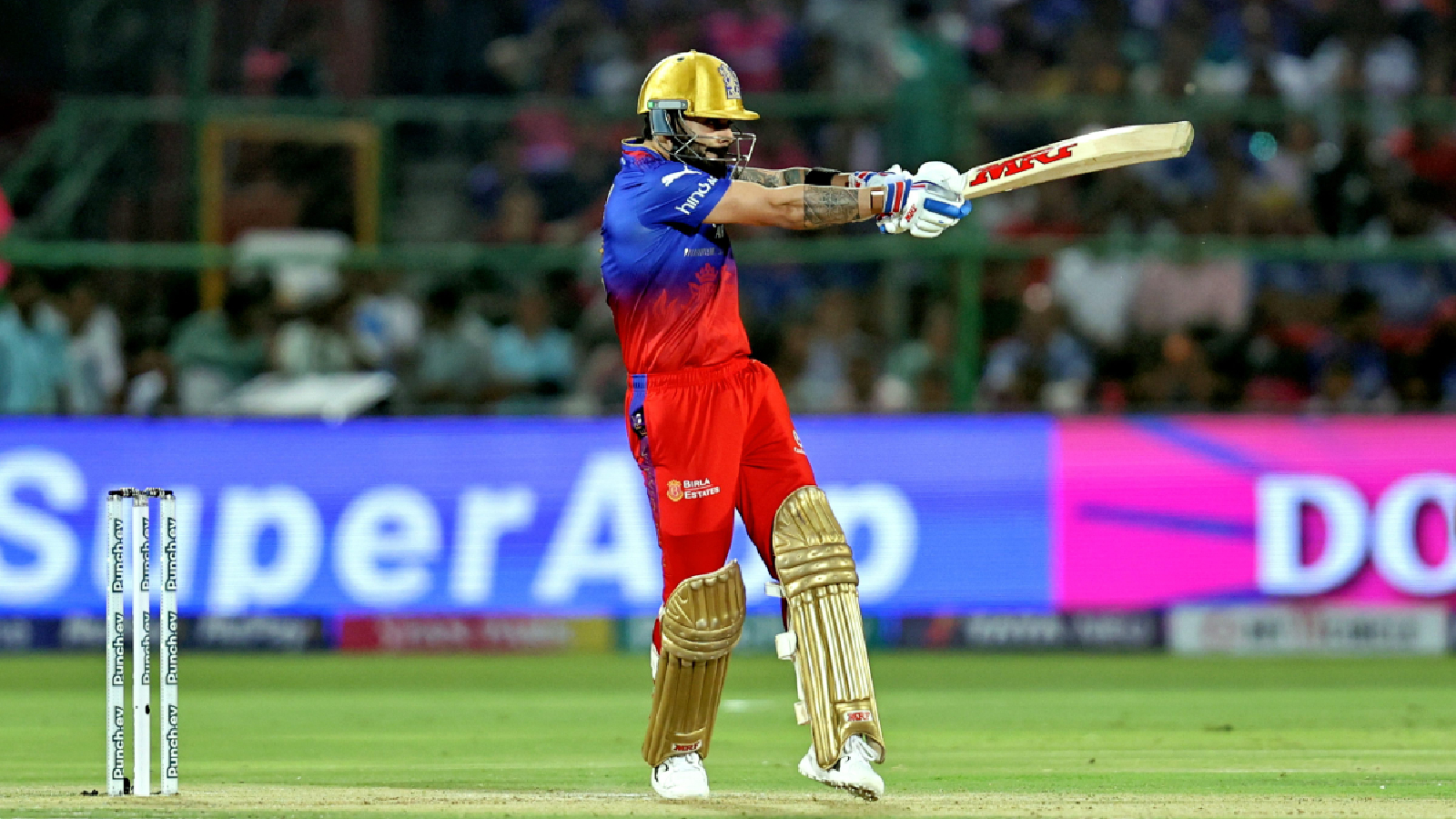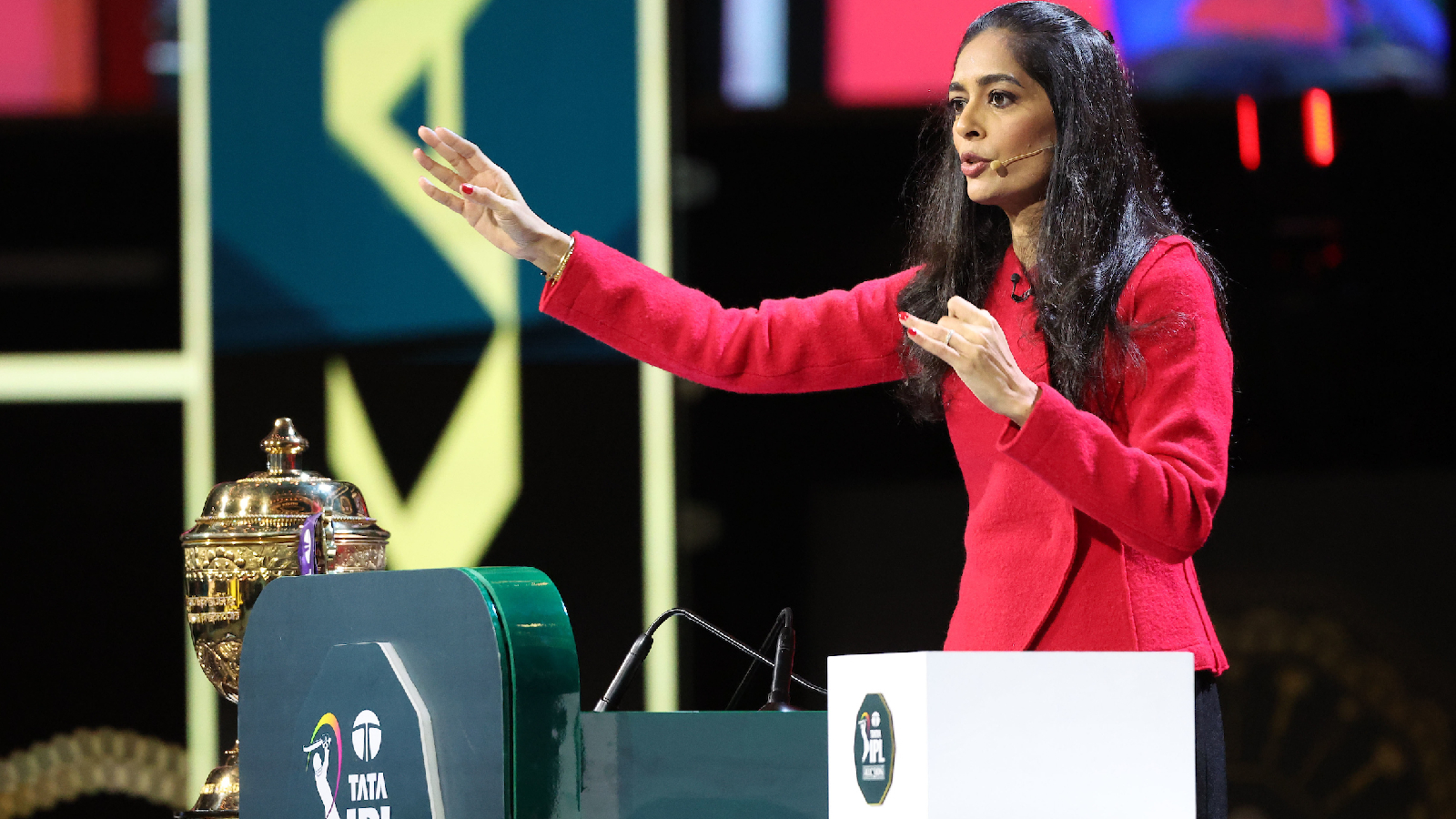Virat Kohli’s unbeaten 113 off 72 deliveries, a record-extending eighth century in the IPL, against Rajasthan Royals was the slowest ton in the history of the tournament and ignited the debate over his efficacy in the format, and the role of sheet anchors in general.
With the Indian squad for the T20 World Cup in the Caribbean and the USA to be named in a week or two, it becomes clear that if Kohli has to be part of the plans, he has to be opening the batting. The T20 format has become one decided by strike rates rather than batting averages, and doesn’t have scope for too many players who are steady and consistent rather than explosive from the outset. Even the great Kohli is not immune to this argument. He can’t afford to slow down in the middle overs after getting a start in the Powerplay.
Rewinding to that evening in Jaipur, Kohli’s ton (which came off 67 balls) batting first on a two-paced surface pushed his team to 183 for three. Only 59 runs were made by the other Royal Challengers Bengaluru batsmen in 48 deliveries, besides 11 extras. What may hold against Kohli is that the team lost only three wickets, but he may have had to hold himself back as the other batsmen in the team were not contributing enough.
Jos Buttler broke the back of the chase with an unbeaten 100 from 58 deliveries that took his team to a five-wicket win, prompting a deeper examination of Kohli’s knock. Two games later, Buttler showed that there was another method to get the job done. Chasing a record 224 against Kolkata Knight Riders, he only got to 50 in 36 deliveries during the 15th over as RR had lost six wickets by then. But in the carnage that followed, Buttler pulled off a spellbinding transformation to end up on 107 off 60 balls for a pulsating last-ball win.
In a way, Buttler’s methods have thrown light on the root of Kohli’s dilemma – the pick-up rates.
The Kohli template
For starters, RCB’s traditional template has meant their batting fortunes are pinned to those of Kohli and Faf du Plessis, with an inconsistent set of players revolving around them – a foundational problem for both the individual and the team.
Since 2023, Kohli has amassed 1,000 runs for RCB, du Plessis closely follows with 962. The two have accounted for 53.91 per cent of the runs (3639) RCB has put up in 21 matches with 19 other batters in the fray. Compare that to Mumbai Indians, the leading run-scoring (3,928) team in the period. Three of MI’s top run-makers – Suryakumar Yadav, Ishan Kishan and Rohit Sharma – form only 48 per cent of the team’s runs since 2023, illustrating the variety and a better opportunity for diverse roles of each batsman in the line-up. MI’s strike rate for this period is 153.49, and RCB rank fourth with 146.85.
Within this, Kohli has scored at a strike rate of 142.45 while Du Plessis has gone at 153.92. They have been the most prolific (1,282 runs) opening pair over the last one-and-a-half seasons. However, it has not prevented the team being at the bottom of the points table.
Kohli has not relied on blocks of big hitting, and the league’s leading run-scorer will always be considered as its biggest anchor/accumulator. His overall IPL Powerplay strike rate stands at 120.05. In 2016, his best season, he went at 119.06 in the first six in 16 innings but capitalised on the 13 occasions he went into the middle overs. Kohli plundered 490 runs in the middle overs that season at a 150.76 strike rate – nearly 25 runs better than his career overall in the phase.
Though his Powerplay returns improved in the following years, Kohli’s experienced a dip in the middle overs, particularly against spin. Between the 2017 and 2022, he amassed 931 runs at an average of 44.33 against tweakers between overs 7-16. However, his strike rate (114.79) was the lowest among 11 batters who compiled at least 750 runs in the period. His corresponding strike rate against pace was a shade above 120.
While Kohli’s strike rate has seen an uptick in the Powerplay and middle overs since the 2023 edition, the pick-up rate after getting a start is still middling compared to Buttler, currently the league’s most proficient opener, with six matchwinning centuries in his last 36 innings since 2022.
During this period, the Englishman has struck watchfully (SR: 130.94) in the Powerplay, even marginally lower than Kohli (134.67). Both have been clear with their intent to play long, last the six overs, and anchor the innings. But it is in the middle overs where Buttler trumps Kohli by a staggering margin, striking at 147.80 while Kohli decelerates to a 130.22 strike rate.
If all these are preconditions to have Kohli in India’s T20 set-up, it becomes clear that only the opener’s slot makes it viable for his accumulation-before-explosion method.
What are India’s options?
With two successive underwhelming campaigns at the T20 World Cup, India must see a stylistic overhaul at the earliest to improve their fortunes this year. Kohli may not be a viable option for India at number three but can, at best, employ his T20 skillset as an opener as he does in the IPL, enabling an earlier entrance for quicker scorers in the middle order.
| In IPL since 2023 | Virat Kohli | Rohit Sharma | Shubman Gill | Yashasvi Jaiswal |
|
Innings |
21 | 21 | 24 | 21 |
|
Runs |
1000 | 593 | 1153 | 746 |
|
Average |
58.82 | 29.65 | 54.90 | 37.3 |
| Strike Rate | 142.45 | 147.14 | 156.23 | 160.43 |
| 100/50s | 3/8 | 1/2 | 3/6 | 1/5 |
| 4s/6s | 100/30 | 63/32 | 106/42 | 100/28 |
While captain Rohit Sharma is confirmed at one end, Kohli is likely to be in contention with Shubman Gill and Yashasvi Jaiswal. Since 2023, Kohli (468), Gill (474) and Jaiswal (467) have accumulated almost the same runs in the Powerplay. The left-handed Jaiswal stands out with his intent, scoring more than 10 runs per over. The aggression has come with greater risk, as he has fallen in 11 out of 21 innings within the Powerplay while doing a fair job. Gill (rpo 8.75) and Kohli (8.38) operate by taking fewer chances in the phase.
| In IPL Powerplay since 2023 | Virat Kohli | Rohit Sharma | Shubman Gill | Yashasvi Jaiswal |
|
Innings |
21 | 21 | 24 | 21 |
|
Runs |
467 | 390 | 474 | 466 |
|
Average |
77.83 | 32.5 | 67.71 | 37.3 |
| Strike Rate | 139.82 | 147.72 | 145.84 | 168.23 |
| 4s/6s | 63/6 | 40/25 | 63/12 | 73/16 |
| In Middle Overs since 2023 | Virat Kohli | Rohit Sharma | Shubman Gill | Yashasvi Jaiswal |
|
Innings |
15 | 9 | 17 | 9 |
|
Runs |
437 | 172 | 569 | 241 |
|
Average |
48.55 | 24.57 | 51.72 | 34.42 |
| Strike Rate | 137.42 | 140.98 | 158.93 | 138.5 |
| 4s/6s | 30/15 | 19/6 | 39/22 | 22/9 |
However, while Gill (9.53) improves his striking by nearly 10 runs in the middle overs, Kohli stagnates at 8.20 while Jaiswal comes down to 8.31. A direct correlation can be seen between these striking patterns and their handling of spin between overs 7-16 – Gill leads with a 158.93 SR, while Kohli (133.96) and Jaiswal (138.88) show reticence. Interestingly, Gill and Kohli have played six innings each at the death (overs 16-20) where their strike rates hit their respective peaks. Jaiswal, on the other hand, has only reached the slog overs once, scoring 39 off 14.
Though Gill’s numbers are healthy on the whole, it may be noted that almost 63 percent of his runs have come at his home venue – the Narendra Modi Stadium in Ahmedabad – over the last two seasons. Kohli’s corresponding accumulation in Bengaluru amounts to 57 per cent while Jaiswal has only scored 39.4 percent in Jaipur.
| T20Is since 2020 |
Virat Kohli |
Rohit Sharma |
| Innings |
33 |
46 |
| Runs |
1223 |
1334 |
| Average |
48.55 |
31.76 |
| Strike Rate |
137.42 |
145.15 |
| 100/50s |
1/12 |
1/10 |
| 4s/6s |
101/38 |
125/70 |
| Balls per six |
23.31 |
13.12 |
| Balls per boundary |
6.37 |
4.71 |
| T20I career stats (debuts in 2023) |
Shubman Gill |
Yashasvi Jaiswal |
| Innings |
14 |
16 |
| Runs |
335 |
502 |
| Average |
25.76 |
33.46 |
| Strike Rate |
147.57 |
161.93 |
| 100/50s |
1/1 |
1/4 |
| 4s/6s |
31/16 |
55/28 |
| Balls per six |
14.18 |
11.07 |
| Balls per boundary |
4.82 |
3.73 |
In the last T20I series India played in January, Jaiswal leapfrogged Gill as the favoured opening partner for Rohit, with Kohli at 3. If one were to go by recent IPL data, Rohit and Jaiswal are the pair for quicker starts, albeit with greater risk of not crossing the Powerplay.
Jaiswal’s indifferent start to this IPL season may force the selectors into a deeper deliberation and take a look at the characteristically orthodox Kohli’s recent progression on the strike rate front.
I’m Manas Ranjan Sahoo: Founder of “Webtirety Software”. I’m a Full-time Software Professional and an aspiring entrepreneur, dedicated to growing this platform as large as possible. I love to Write Blogs on Software, Mobile applications, Web Technology, eCommerce, SEO, and about My experience with Life.






